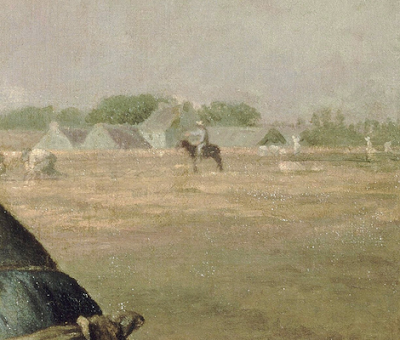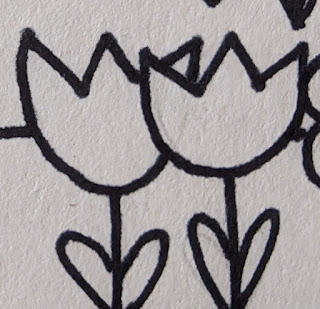Trick #1. Artists create three areas of space; HERE, NEAR, and FAR. Objects that are HERE are found in the Foreground. Foreground is the area of space closest to you in a painting or drawing. FAR is considered the background. Objects are smaller in this area of space as this is the space farthest from you. As objects get further away, they appear to get smaller.
Trick #2. Artists make objects in the foreground larger than objects in the middle ground or background. Notice the flowers in the picture below. They are larger in the foreground. As the flowers get further away, they become smaller and smaller.
Trick #3. As objects get further away, not only do they get smaller, but they get higher on the picture plane (paper). The largest flowers, found in the foreground, are at the bottom of the picture, while the flowers in the background, are closer to the top of the picture.
Trick #4. Artists overlap shapes to give the illusion that one shape is in front of another, which means that the object on top is closer. Notice the two flowers below. One flower is drawn on top of another flower to give the "illusion" that it is closer and in front.
Trick #5. Objects in the foreground have more details, than objects in the middle ground and backgrounds.
If we look at the painting below by Pieter Bruegel the Elder, notice he used some of these same tricks to create the illusion of space. The harvesters at the bottom of the picture are closest to us. We can clearly see their clothes, faces, and even the lunch they are eating. Their size is bigger than the harvesters in the middle ground and background of the painting.
 |
The Harvesters is a Northern Renaissance oil painting created by Pieter Bruegel
the Elder in 1565. It lives at the Metropolitan Museum of Art in New York.
|
 |
Orchard Bordered by Cypresses (1888) by Vincent Van Gogh. |
Trick #1. He created three areas of space; Here (foreground), Near (middle ground), and Far (background). The grass and hut are in the foreground. The orchard is located in the middle ground and the Cypress trees are located in the background.
Trick #2. (Relative Size) Van Gogh painted the trees closest to us much larger than the trees further in the distance. The trees in the background are much smaller. As the path recedes in space or gets further away, it also gets smaller and smaller.
Trick #3. (Location on the paper) The cypress trees in the background are not only further away, but higher in the painting than the grass and path at the bottom of the picture found in the foreground.
Trick #4. (overlapping) Van Gogh overlapped the orchard trees to give the illusion that one tree, the largest tree, is in front and closest to us.
Trick #5. (details) We can see the leaves and branches more clearly on the trees closest to us than the trees further away. The farthest trees have the least amount of details.
 |
| The Gleaners by Jean-Francois Millet in 1857. It lives in the Musee d'Orsay in Paris. |
 |
| Close-up of the background from the Gleaners. |
Try to use some of these same tricks in your own art making!
If you wish to learn more about Pieter Bruegel the Elder, watch the episode of Mati and Dada as they travel back in time and meet the artist in person.





No comments:
Post a Comment